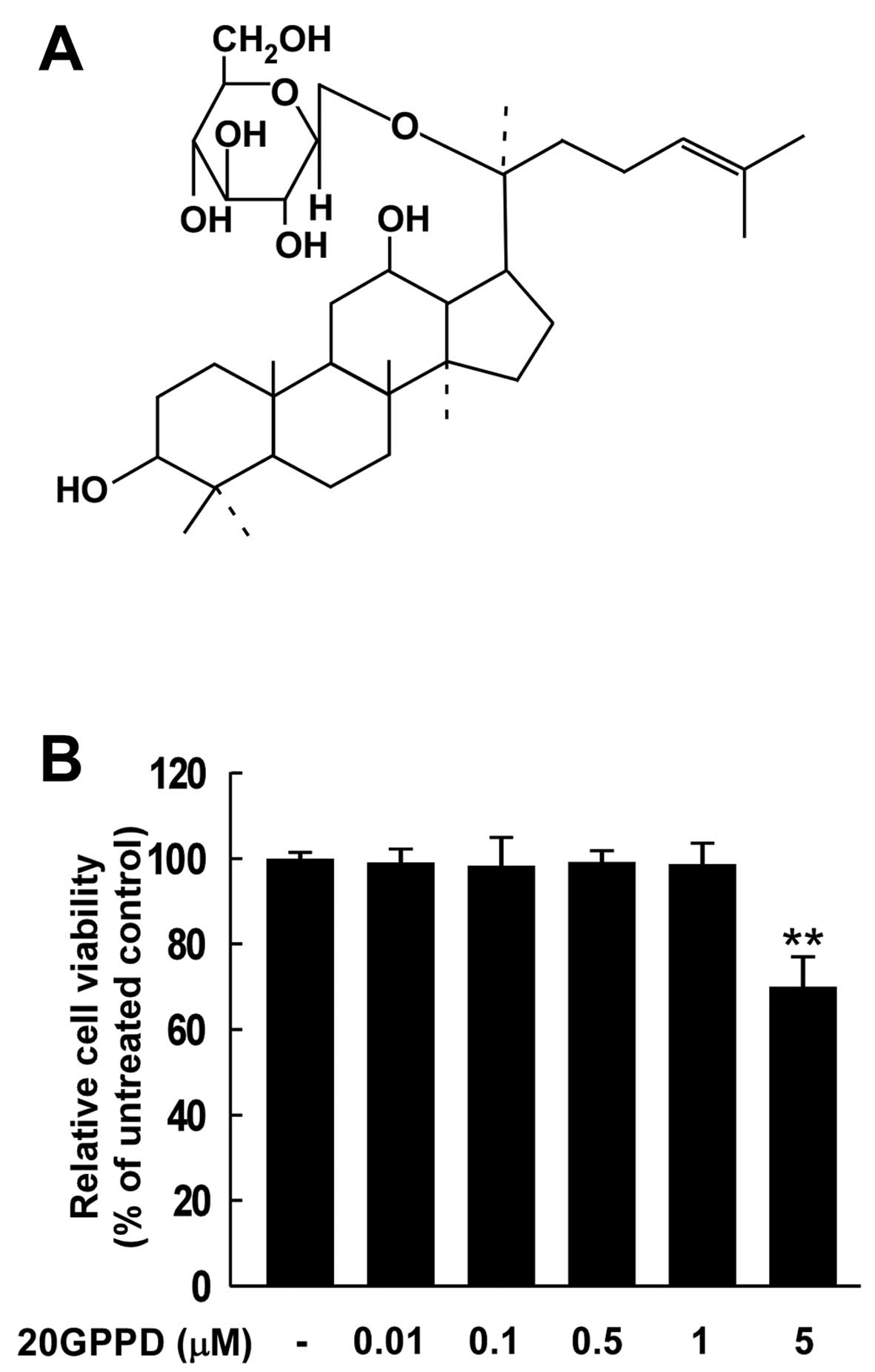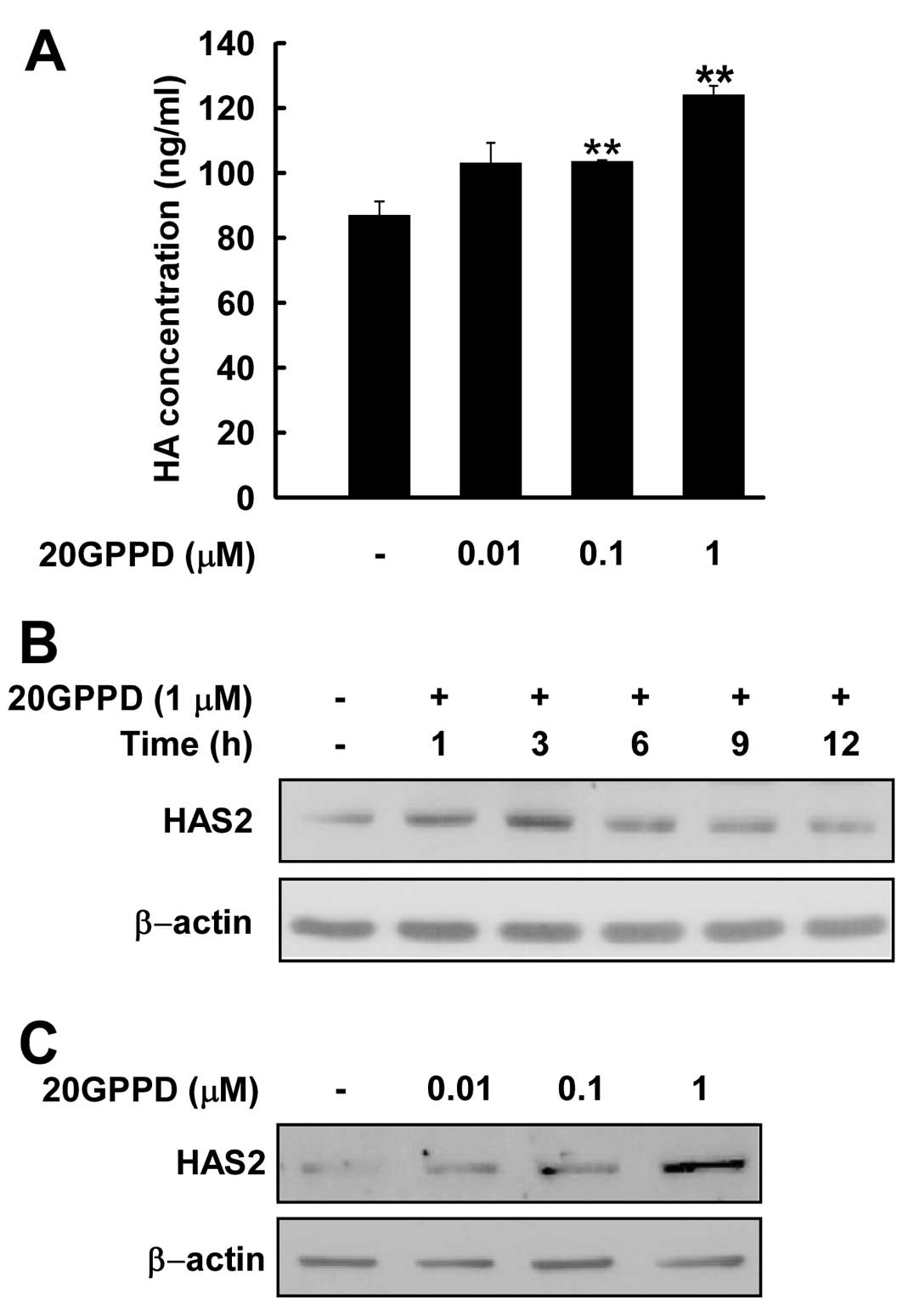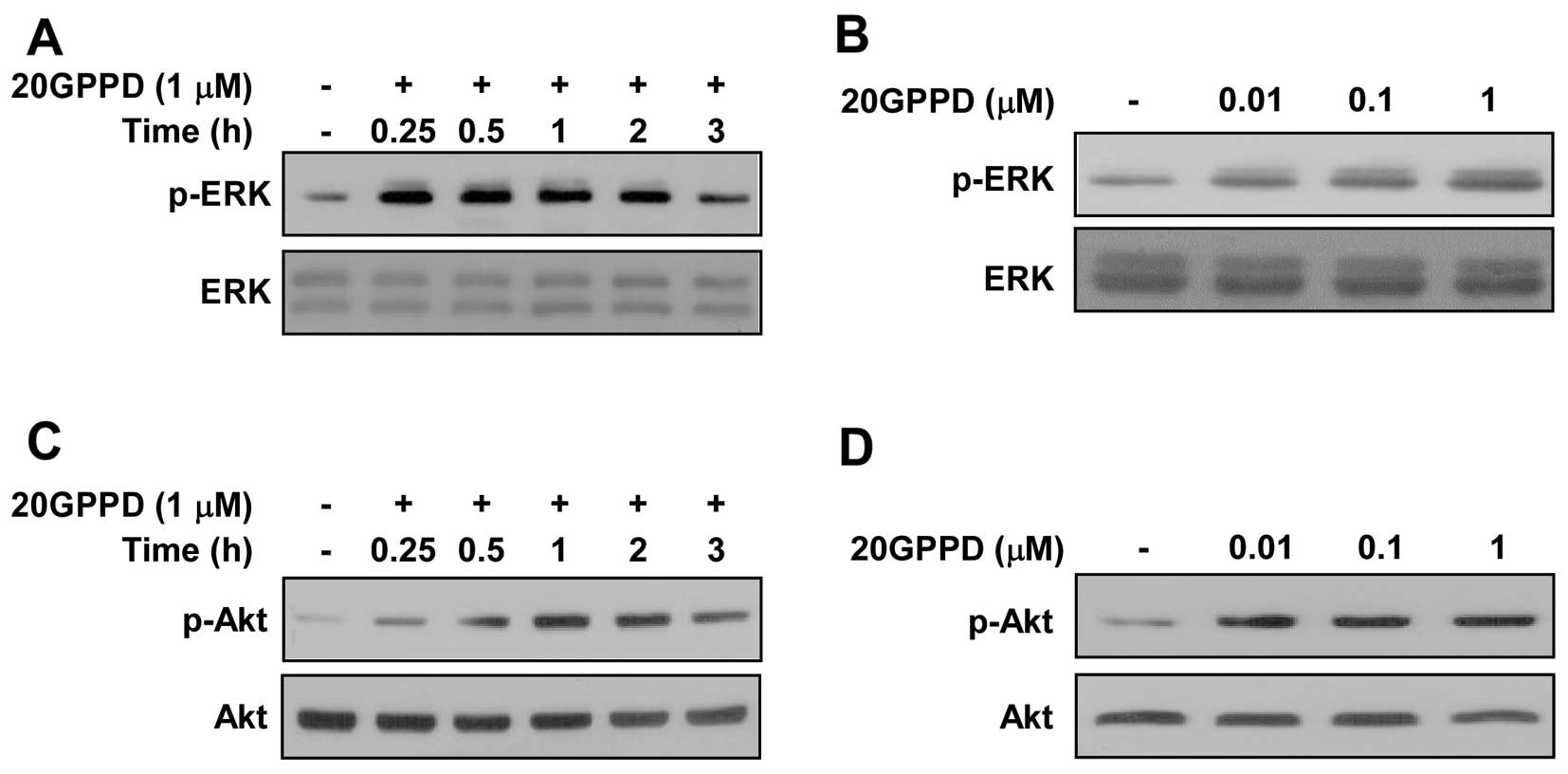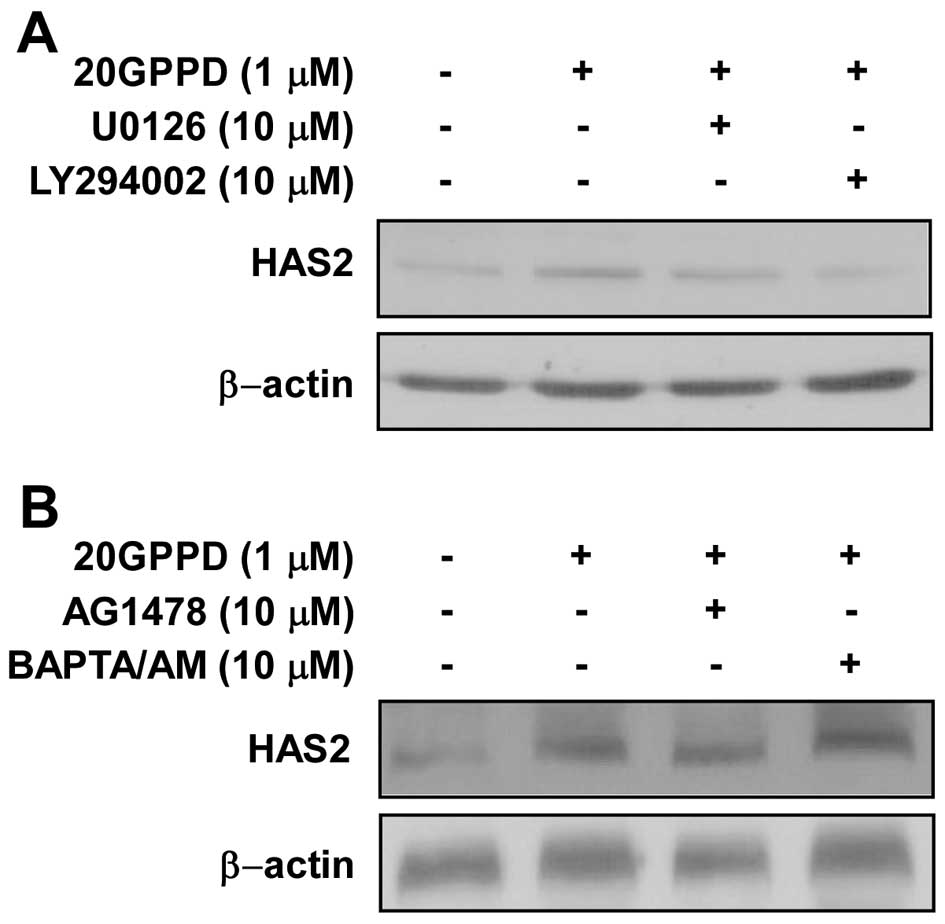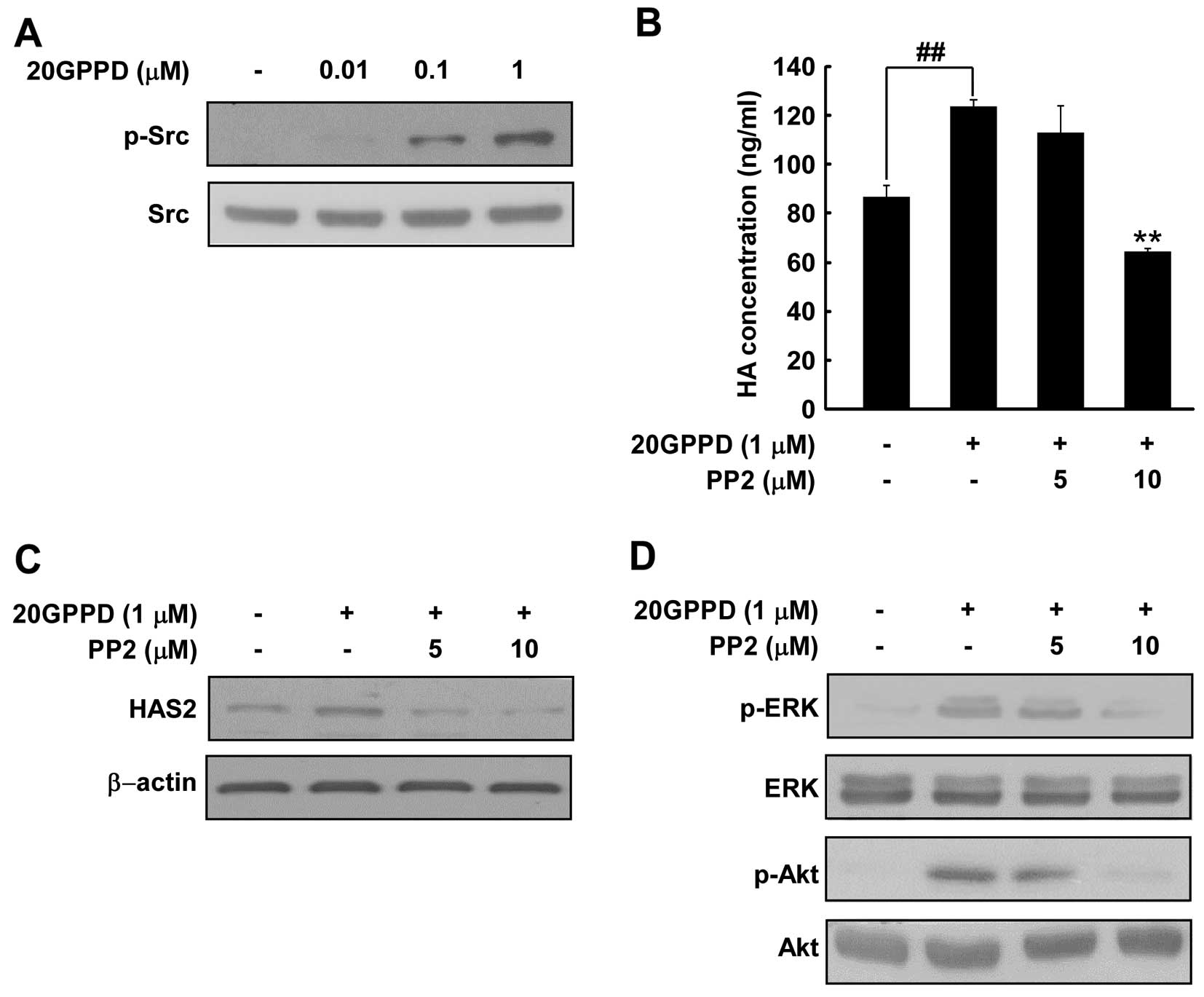|
1
|
Christensen LP: Ginsenosides chemistry,
biosynthesis, analysis, and potential health effects. Adv Food Nutr
Res. 55:1–99. 2009. View Article : Google Scholar
|
|
2
|
Kim WK, Song SY, Oh WK, et al:
Wound-healing effect of ginsenoside Rd from leaves of Panax ginseng
via cyclic AMP-dependent protein kinase pathway. Eur J Pharmacol.
702:285–293. 2013. View Article : Google Scholar : PubMed/NCBI
|
|
3
|
Kimura Y, Sumiyoshi M, Kawahira K and
Sakanaka M: Effects of ginseng saponins isolated from Red Ginseng
roots on burn wound healing in mice. Br J Pharmacol. 148:860–870.
2006. View Article : Google Scholar : PubMed/NCBI
|
|
4
|
Lee HS, Kim MR, Park Y, et al: Fermenting
red ginseng enhances its safety and efficacy as a novel skin care
anti-aging ingredient: in vitro and animal study. J Med Food.
15:1015–1023. 2012. View Article : Google Scholar : PubMed/NCBI
|
|
5
|
He D, Sun J, Zhu X, Nian S and Liu J:
Compound K increases type I procollagen level and decreases matrix
metalloproteinase-1 activity and level in ultraviolet-A-irradiated
fibroblasts. J Formos Med Assoc. 110:153–160. 2011. View Article : Google Scholar : PubMed/NCBI
|
|
6
|
Lou JS, Chen XE, Zhang Y, et al:
Photoprotective and immunoregulatory capacity of ginsenoside Rg1 in
chronic ultraviolet B-irradiated BALB/c mouse skin. Exp Ther Med.
6:1022–1028. 2013.PubMed/NCBI
|
|
7
|
Cai BX, Jin SL, Luo D, Lin XF and Gao J:
Ginsenoside Rb1 suppresses ultraviolet radiation-induced apoptosis
by inducing DNA repair. Biol Pharm Bull. 32:837–841. 2009.
View Article : Google Scholar : PubMed/NCBI
|
|
8
|
Cai BX, Luo D, Lin XF and Gao J: Compound
K suppresses ultraviolet radiation-induced apoptosis by inducing
DNA repair in human keratinocytes. Arch Pharm Res. 31:1483–1488.
2008. View Article : Google Scholar : PubMed/NCBI
|
|
9
|
Cuong TT, Yang CS, Yuk JM, et al:
Glucocorticoid receptor agonist compound K regulates
Dectin-1-dependent inflammatory signaling through inhibition of
reactive oxygen species. Life Sci. 85:625–633. 2009. View Article : Google Scholar : PubMed/NCBI
|
|
10
|
Kim S, Kang BY, Cho SY, et al: Compound K
induces expression of hyaluronan synthase 2 gene in transformed
human keratinocytes and increases hyaluronan in hairless mouse
skin. Biochem Biophys Res Commun. 316:348–355. 2004. View Article : Google Scholar : PubMed/NCBI
|
|
11
|
Hwang JA, Hwang MK, Jang Y, et al:
20-O-β-d-glucopyranosyl-20(S)-protopanaxadiol, a metabolite of
ginseng, inhibits colon cancer growth by targeting TRPC
channel-mediated calcium influx. J Nutr Biochem. 24:1096–1104.
2013. View Article : Google Scholar : PubMed/NCBI
|
|
12
|
Laurent TC and Fraser JR: Hyaluronan.
FASEB J. 6:2397–2404. 1992.PubMed/NCBI
|
|
13
|
Oe M, Mitsugi K, Odanaka W, et al: Dietary
hyaluronic acid migrates into the skin of rats. Scientific World
Journal. 2014:3780242014. View Article : Google Scholar : PubMed/NCBI
|
|
14
|
Toole BP: Hyaluronan in morphogenesis. J
Intern Med. 242:35–40. 1997. View Article : Google Scholar : PubMed/NCBI
|
|
15
|
Pasonen-Seppänen SM, Maytin EV, Törrönen
KJ, et al: All-trans retinoic acid-induced hyaluronan production
and hyperplasia are partly mediated by EGFR signaling in epidermal
keratinocytes. J Invest Dermatol. 128:797–807. 2008. View Article : Google Scholar
|
|
16
|
Stern R and Maibach HI: Hyaluronan in
skin: aspects of aging and its pharmacologic modulation. Clin
Dermatol. 26:106–122. 2008. View Article : Google Scholar : PubMed/NCBI
|
|
17
|
Tammi RH and Tammi MI: Hyaluronan
accumulation in wounded epidermis: a mediator of keratinocyte
activation. J Invest Dermatol. 129:1858–1860. 2009. View Article : Google Scholar : PubMed/NCBI
|
|
18
|
Weigel PH, Hascall VC and Tammi M:
Hyaluronan synthases. J Biol Chem. 272:13997–14000. 1997.
View Article : Google Scholar : PubMed/NCBI
|
|
19
|
Spicer AP and McDonald JA:
Characterization and molecular evolution of a vertebrate hyaluronan
synthase gene family. J Biol Chem. 273:1923–1932. 1998. View Article : Google Scholar : PubMed/NCBI
|
|
20
|
Camenisch TD, Spicer AP, Brehm-Gibson T,
et al: Disruption of hyaluronan synthase-2 abrogates normal cardiac
morphogenesis and hyaluronan-mediated transformation of epithelium
to mesenchyme. J Clin Invest. 106:349–360. 2000. View Article : Google Scholar : PubMed/NCBI
|
|
21
|
Tammi RH, Passi AG, Rilla K, et al:
Transcriptional and post-translational regulation of hyaluronan
synthesis. FEBS J. 278:1419–1428. 2011. View Article : Google Scholar : PubMed/NCBI
|
|
22
|
Pasonen-Seppänen S, Karvinen S, Törrönen
K, et al: EGF upregulates, whereas TGF-beta downregulates, the
hyaluronan synthases Has2 and Has3 in organotypic keratinocyte
cultures: correlations with epidermal proliferation and
differentiation. J Invest Dermatol. 120:1038–1044. 2003. View Article : Google Scholar : PubMed/NCBI
|
|
23
|
Li L, Asteriou T, Bernert B, Heldin CH and
Heldin P: Growth factor regulation of hyaluronan synthesis and
degradation in human dermal fibroblasts: importance of hyaluronan
for the mitogenic response of PDGF-BB. Biochem J. 404:327–336.
2007. View Article : Google Scholar : PubMed/NCBI
|
|
24
|
Thomas SM and Brugge JS: Cellular
functions regulated by Src family kinases. Annu Rev Cell Dev Biol.
13:513–609. 1997. View Article : Google Scholar : PubMed/NCBI
|
|
25
|
Bourguignon LY, Zhu H, Shao L and Chen YW:
CD44 interaction with c-Src kinase promotes cortactin-mediated
cytoskeleton function and hyaluronic acid-dependent ovarian tumor
cell migration. J Biol Chem. 276:7327–7336. 2001. View Article : Google Scholar
|
|
26
|
Schlessinger J: New roles for Src kinases
in control of cell survival and angiogenesis. Cell. 100:293–296.
2000. View Article : Google Scholar : PubMed/NCBI
|
|
27
|
Stuhlmeier KM and Pollaschek C:
Differential effect of transforming growth factor beta (TGF-beta)
on the genes encoding hyaluronan synthases and utilization of the
p38 MAPK pathway in TGF-beta-induced hyaluronan synthase 1
activation. J Biol Chem. 279:8753–8760. 2004. View Article : Google Scholar
|
|
28
|
Monslow J, Sato N, Mack JA and Maytin EV:
Wounding-induced synthesis of hyaluronic acid in organotypic
epidermal cultures requires the release of heparin-binding egf and
activation of the EGFR. J Invest Dermatol. 129:2046–2058. 2009.
View Article : Google Scholar : PubMed/NCBI
|
|
29
|
Oh JH, Kim YK, Jung JY, Shin JE and Chung
JH: Changes in glycosaminoglycans and related proteoglycans in
intrinsically aged human skin in vivo. Exp Dermatol. 20:454–456.
2011. View Article : Google Scholar : PubMed/NCBI
|
|
30
|
Zhang L, Teng Y, Zhang Y, et al:
C-Src-mediated RANKL-induced breast cancer cell migration by
activation of the ERK and Akt pathway. Oncol Lett. 3:395–400.
2012.PubMed/NCBI
|
|
31
|
Liu G, Hitomi H, Hosomi N, et al: Prorenin
induces vascular smooth muscle cell proliferation and hypertrophy
via epidermal growth factor receptor-mediated extracellular
signal-regulated kinase and Akt activation pathway. J Hypertens.
29:696–705. 2011. View Article : Google Scholar : PubMed/NCBI
|
|
32
|
Paek IB, Moon Y, Kim J, et al:
Pharmacokinetics of a ginseng saponin metabolite compound K in
rats. Biopharm Drug Dispos. 27:39–45. 2006. View Article : Google Scholar
|
|
33
|
Karvinen S, Pasonen-Seppänen S, Hyttinen
JM, et al: Keratinocyte growth factor stimulates migration and
hyaluronan synthesis in the epidermis by activation of keratinocyte
hyaluronan synthases 2 and 3. J Biol Chem. 278:49495–49504. 2003.
View Article : Google Scholar : PubMed/NCBI
|
|
34
|
Kim do Y, Park MW, Yuan HD, Lee HJ, Kim SH
and Chung SH: Compound K induces apoptosis via CAMK-IV/AMPK
pathways in HT-29 colon cancer cells. J Agric Food Chem.
57:10573–10578. 2009. View Article : Google Scholar : PubMed/NCBI
|
|
35
|
Lee JH, Jeong SM, Kim JH, et al: Effects
of ginsenosides and their metabolites on voltage-dependent Ca(2+)
channel subtypes. Mol Cells. 21:52–62. 2006.PubMed/NCBI
|
|
36
|
Saavalainen K, Pasonen-Seppänen S, Dunlop
TW, Tammi R, Tammi MI and Carlberg C: The human hyaluronan synthase
2 gene is a primary retinoic acid and epidermal growth factor
responding gene. J Biol Chem. 280:14636–14644. 2005. View Article : Google Scholar : PubMed/NCBI
|
|
37
|
Tang ZN, Zhang F, Tang P, Qi XW and Jiang
J: RANKL-induced migration of MDA-MB-231 human breast cancer cells
via Src and MAPK activation. Oncol Rep. 26:1243–1250.
2011.PubMed/NCBI
|
|
38
|
Zhuang S, Duan M and Yan Y: Src family
kinases regulate renal epithelial dedifferentiation through
activation of EGFR/PI3K signaling. J Cell Physiol. 227:2138–2144.
2012. View Article : Google Scholar
|
|
39
|
Yang CX, Liu YW, He YQ and Gao F: Src
kinase-MAPK signal pathway plays a role in proliferation of
endothelial cells induced by o-HA. Fen Zi Xi Bao Sheng Wu Xue Bao.
39:495–501. 2006.In Chinese.
|
|
40
|
Vigetti D, Deleonibus S, Moretto P, et al:
Role of UDP-N-acetylglucosamine (GlcNAc) and O-GlcNAcylation of
hyaluronan synthase 2 in the control of chondroitin sulfate and
hyaluronan synthesis. J Biol Chem. 287:35544–35555. 2012.
View Article : Google Scholar : PubMed/NCBI
|















